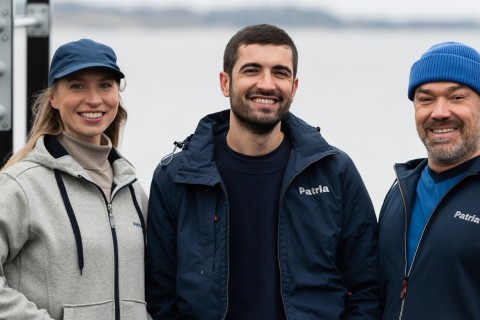
30.5.2023
Patria is closely involved in European defence technology research projects that are laying the foundations for cutting-edge products. These include new solutions for naval warfare.
Patria is involved in several research and development projects that are developing defence technologies through European collaboration. This R&D includes solutions for naval intelligence and maritime surveillance. One good example is the PADIC project, in which Patria is working with its international partners to develop an open-architecture coastal radar network system. The network combines various types of passive sensors to detect targets on land, at sea and in the air.
– The system being developed in the PADIC project leverages Patria’s MUSCL passive radar. It’s a cost-effective and scalable solution that enables a high-performance and easy-to-deploy surveillance system that is difficult to detect, says Director, ISTAR Sensor Systems Kalle Martikainen.
Patria has been systematically developing passive sensors for more than 15 years. These sensors form part of the company’s extensive C5ISTAR product portfolio.
Passive radar is invisible to the enemy
MUSCL utilises reflections of television and radio signals, and does not transmit anything itself. This kind of passive radar is therefore practically invisible to enemy signal intelligence and cannot be destroyed by anti-radiation missiles.
According to Niko Haka, Key Account Director, Navy, the maritime and air surveillance sensors of the future will be small, multistatic, transportable and networked.
Additionally, by utilising commercially available technologies and components, repairing or even replacing the systems will be easier, faster and more cost-efficient in the future. Combined with passive radar technology, Patria MUSCL forms a very resilient entity to meet all these future requirements.
– The system enables authorities to organise affordable area or point surveillance for a broad range of purposes, such as air surveillance, border surveillance, protecting critical infrastructure, or detecting unmanned aerial vehicles.
In Niko Haka’s opinion, it must also be possible to effectively integrate passive radar the broader command and control system. It will also be possible to combine electronic intelligence and surveillance systems with passive radar network in the future to get more specific information of contacts of interests in the area of operations.
For example, Patria’s ARIS product family provides powerful tools for electronic intelligence and surveillance, such as real-time radar signal interception, recording and analysis capabilities.
Cost-effective solutions through R&D
Kimmo Jämsen, Director, Underwater Systems, says that research projects aimed at enhancing the naval capabilities of EU countries share common features, that is, a focus on minesweeping, underwater surveillance, target acquisition and communication with the aid of unmanned autonomous surface and underwater vessels.
– The package will consist of new technological solutions and updates to existing systems that operate seamlessly with new solutions. This will bring much-needed cost-effectiveness.
For years, Patria has been involved in defence R&D collaboration with a number of EU countries, research institutes and companies under the European Defence Agency (EDA). In the future, this work will also be carried out within the framework of the European Defence Fund (EDF).
Passive sensors form part of the C5ISTAR product portfolio
Niko Haka notes that Patria is also actively involved in the R&D activities carried out by the Finnish Defence Forces, such as exploring future opportunities for using unmanned autonomous vessels. Patria’s European research collaboration also focuses on projects that are based on Finnish needs, but can later be utilised to meet the needs of all military services and other customers. Good example of this is the PADIC project (which focuses on land, sea and air surveillance in coastal areas) and Patria’s MUSCL passive radar system.
More effective mine clearance with Patria’s mine sweep
– The EDA’s MLM projects for naval mine warfare provided a significant boost to Patria’s product offering. Patria has developed an influence minesweeping concept together with its international partners, and the company’s SONAC ACS acoustic mine sweep prototype played a key role in sea trials. Patria’s product is capable of generating broadband acoustic signals with high acoustic pressure. This enables an excellent response to the smart signal processing and algorithms used by modern influence mines, which are difficult or impossible for existing acoustic mine sweeps to deal with, says Product Manager - Underwater Systems, Petri Salmela.
Patria is also actively involved in the Finnish Defence Forces’ R&D activities
One of the SONAC ACS’s strengths is that its settings can be adjusted as necessary during a mission. For example, the acoustic signal sent by the mine sweep can be changed in real time by downloading an alternative signal from the library or creating a vessel-specific or other optional.
– Thanks to its small size and low weight, the mine sweep can be used with both small vessels and unmanned autonomous surface vessels.
Salmela says that the prototype developed during the EDA projects has been shown to have a high level of performance, which has led to international sales and growing interest all across the world.
Patria has also been involved in other projects, such as the EDA’s ETLAT, in which the company has worked with its European partners to develop lightweight hydrophone surveillance technology for use in unmanned autonomous systems.
– This project is highly significant for the development of future underwater surveillance systems.
Unmanned vessels play a major role in naval warfare
Niko Haka expects that unmanned vessels will play an even more significant role in maritime surveillance in the future. This trend is being driven by technological advancements and a growing need to monitor larger sea areas and their infrastructure.
– The high cost of acquiring and operating modern manned warships means that the Navy cannot acquire the number of vessels it would need to achieve similar capabilities in a cost-effective manner.
Haka says that, in addition to the increasing role that will be played by unmanned systems, future maritime surveillance capabilities will consist of a combination of fixed, portable and mobile solutions that will be intelligently networked both with each other and existing command and control systems. This will require reliable wireless data transfer. It is also true of underwater systems, which is why Patria has been participating in the EDA’s underwater communications projects for many years.
What did you like about the article?
Thank you for your opinion! You can share the article on social media using the buttons below:



























